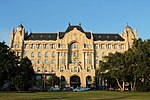Vigadó of Pest

Vigadó (usually translated as "Place for Merriment") is Budapest's second largest concert hall, located on the Eastern bank of the Danube in Budapest, Hungary. Although the acoustics are lacking, the building itself, designed by Frigyes Feszl in 1859, makes a bold impression along the Pest embankment. Built to replace another concert hall on the same site (which was destroyed by fire in the 1848 War of Independence) Feszl's Vigadó was also badly damaged, this time during World War II. The post-war reconstruction, which took some thirty-six years to complete, remains faithful to his original design and continues to attract leading conductors and performers from around the world. The facade of the Vigadó was cleaned and restored in 2006. The Budai Vigadó is the home stage of the Hungarian State Folk Ensemble (The House of Traditions), the group having started in 1951 with Hungarian traditional dance and music. The group consists of 30 dancers, a Gypsy band of 14, and a 5-member folk band.
Excerpt from the Wikipedia article Vigadó of Pest (License: CC BY-SA 3.0, Authors, Images).Vigadó of Pest
Vigadó tér, Budapest Lipótváros
Geographical coordinates (GPS) Address Phone number Website External links Nearby Places Show on map
Geographical coordinates (GPS)
| Latitude | Longitude |
|---|---|
| N 47.495894444444 ° | E 19.049455555556 ° |
Address
Pesti Vigadó (Vigadó)
Vigadó tér 2
1051 Budapest, Lipótváros
Hungary
Open on Google Maps










